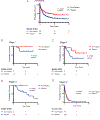Hispanic/Latino Ethnicity Is an Independent Predictor of Worse Survival for Gastric Cancer in a Multicenter Safety-Net Patient Population
- PMID: 39158462
- PMCID: PMC11717642
- DOI: 10.1158/1055-9965.EPI-23-1224
Hispanic/Latino Ethnicity Is an Independent Predictor of Worse Survival for Gastric Cancer in a Multicenter Safety-Net Patient Population
Abstract
Background: Various population-based studies have shown Hispanic/Latino ethnicity is a risk factor for worse survival in patients with gastric cancer linked to disparate access to care. We aimed to address whether Hispanic patients treated within safety-net hospital systems continue to experience this survival deficit compared to non-Hispanic patients.
Methods: We performed a retrospective cohort study comparing survival between Hispanic and non-Hispanic patients diagnosed with gastric adenocarcinoma between January 1, 2016, and December 31, 2020, within Los Angeles County's safety-net hospital system. Gastric cancer-specific survival was compared between the two cohorts using the Kaplan-Meier estimate and Cox proportional-hazards regression model.
Results: In total, 448 patients who received care from five medical centers were included; 348 (77.7%) patients self-identified as Hispanic and 100 (22.3%) as non-Hispanic. Mean follow-up time was 2.0 years (median 0.91 years, IQR, 0.34-2.5 years). Hispanic patients were found to be diagnosed at a younger age (55.6 vs. 60.7 years, P < 0.01), demonstrate higher state area deprivation index (6.4 vs. 5.0, P < 0.01), and present with metastatic disease (59.8% vs. 45%, P = 0.04). After adjusting social and oncologic variables, Hispanic ethnicity remained an independent risk factor for worse survival [HR 1.56, (95% CI, 1.06-2.28); P = 0.02].
Conclusions: Hispanic patients treated within a large, multicenter safety-net hospital system experience worse survival compared to non-Hispanic patients. This suggests ethnic disparities exist within safety-net hospital systems, independent of known clinicopathologic factors.
Impact: Improving outcomes for Hispanic patients with gastric cancer requires future efforts aimed at defining and addressing these unidentified barriers to care. See related In the Spotlight, p. 12.
©2024 American Association for Cancer Research.
Conflict of interest statement
Figures


Similar articles
-
Comparison of Two Modern Survival Prediction Tools, SORG-MLA and METSSS, in Patients With Symptomatic Long-bone Metastases Who Underwent Local Treatment With Surgery Followed by Radiotherapy and With Radiotherapy Alone.Clin Orthop Relat Res. 2024 Dec 1;482(12):2193-2208. doi: 10.1097/CORR.0000000000003185. Epub 2024 Jul 23. Clin Orthop Relat Res. 2024. PMID: 39051924
-
Do Patients of Different Levels of Affluence Receive Different Care for Pediatric Osteosarcomas? One Institution's Experience.Clin Orthop Relat Res. 2025 Apr 1;483(4):748-758. doi: 10.1097/CORR.0000000000003299. Epub 2024 Oct 30. Clin Orthop Relat Res. 2025. PMID: 39485923
-
Are Current Survival Prediction Tools Useful When Treating Subsequent Skeletal-related Events From Bone Metastases?Clin Orthop Relat Res. 2024 Sep 1;482(9):1710-1721. doi: 10.1097/CORR.0000000000003030. Epub 2024 Mar 22. Clin Orthop Relat Res. 2024. PMID: 38517402
-
Systemic pharmacological treatments for chronic plaque psoriasis: a network meta-analysis.Cochrane Database Syst Rev. 2017 Dec 22;12(12):CD011535. doi: 10.1002/14651858.CD011535.pub2. Cochrane Database Syst Rev. 2017. Update in: Cochrane Database Syst Rev. 2020 Jan 9;1:CD011535. doi: 10.1002/14651858.CD011535.pub3. PMID: 29271481 Free PMC article. Updated.
-
Cost-effectiveness of using prognostic information to select women with breast cancer for adjuvant systemic therapy.Health Technol Assess. 2006 Sep;10(34):iii-iv, ix-xi, 1-204. doi: 10.3310/hta10340. Health Technol Assess. 2006. PMID: 16959170
Cited by
-
Molecular Alterations in TP53, WNT, PI3K, TGF-Beta, and RTK/RAS Pathways in Gastric Cancer Among Ethnically Heterogeneous Cohorts.Cancers (Basel). 2025 Mar 23;17(7):1075. doi: 10.3390/cancers17071075. Cancers (Basel). 2025. PMID: 40227587 Free PMC article.
-
CT Imaging as a Single Modality for Clinical Staging of Gastric Cancer in Limited Resource Centers: A Retrospective Pilot Study.J Surg Oncol. 2024 Dec;130(8):1551-1562. doi: 10.1002/jso.27857. Epub 2024 Oct 15. J Surg Oncol. 2024. PMID: 39410745 Free PMC article.
References
-
- Dong E, Duan L, Wu BU. Racial and Ethnic Minorities at Increased Risk for Gastric Cancer in a Regional US Population Study. Clin Gastroenterol Hepatol. 2017;15:511–7. - PubMed
Publication types
MeSH terms
Grants and funding
LinkOut - more resources
Full Text Sources
Medical

